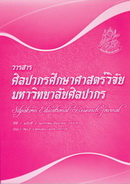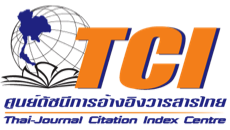การศึกษาปัจจัยที่ส่งผลต่อพฤติกรรมการเรียนที่ดีของนักเรียนชั้นมัธยมศึกษาปีที่ 3 สังกัดสำนักบริหารงานคณะกรรมการส่งเสริมการศึกษาเอกชน จังหวัดนครปฐม
บทคัดย่อ
บทคัดย่อ
การวิจัยครั้งนี้ มีวัตถุประสงค์ 1) เพื่อศึกษาระดับพฤติกรรมการเรียนที่ดีของนักเรียน 2) เพื่อศึกษาปัจจัยสภาพแวดล้อมทางสังคมและปัจจัยทางจิตวิทยาที่ส่งผลต่อพฤติกรรมการเรียนที่ดีของนักเรียน 3) เพื่อเปรียบเทียบพฤติกรรมการเรียนที่ดีของนักเรียน เมื่อจำแนกตามปัจจัยส่วนบุคคล กลุ่มตัวอย่างในการวิจัย คือ นักเรียนชั้นมัธยมศึกษาปีที่ 3 สังกัดสำนักบริหารงานคณะกรรมการส่งเสริมการศึกษาเอกชน จังหวัดนครปฐม ปีการศึกษา 2552 การสุ่มกลุ่มตัวอย่างแบบหลายขั้นตอน กำหนดขนาดของกลุ่มตัวอย่างโดยใช้ตารางของทาโร ยามาเน่ และเลือกตัวอย่างแบบเจาะจง กลุ่มตัวอย่างที่ได้ถูกจำแนกเป็น 2 กลุ่ม 1) กลุ่มตัวอย่างที่ตอบแบบสอบถาม จำนวน 334 คน และ 2) กลุ่มตัวอย่างที่ทำการศึกษาโดยสัมภาษณ์เชิงลึก จำนวน 18 คน ระยะเวลาในการเก็บข้อมูลระหว่างเดือนพฤศจิกายน 2552 – เดือนมกราคม 2553 เครื่องมือที่ใช้ในการวิจัยเป็นแบบสอบถามและแบบสัมภาษณ์เชิงลึก เครื่องมือเหล่านี้มีวัตถุประสงค์เพื่อหาข้อมูลเกี่ยวกับปัจจัยส่วนบุคคล ปัจจัยสภาพแวดล้อมทางสังคม ปัจจัยทางจิตวิทยาและพฤติกรรมการเรียนที่ดีของนักเรียน สถิติที่ใช้วิเคราะห์ข้อมูล ได้แก่ ค่าความถี่ ค่าร้อยละ ค่าเฉลี่ย ส่วนเบี่ยงเบนมาตรฐาน การทดสอบค่าที การวิเคราะห์ความแปรปรวนทางเดียว การวิเคราะห์การถดถอยพหุคูณแบบขั้นตอน และการวิเคราะห์ข้อมูลเชิงคุณภาพใช้การวิเคราะห์เนื้อหา
ผลการวิจัยสรุปได้ดังนี้ 1) ระดับของพฤติกรรมการเรียนที่ดีของนักเรียน พบว่า นักเรียนมีพฤติกรรมการเรียนที่ดีอยู่ในระดับปานกลาง 2) ปัจจัยสภาพแวดล้อมทางสังคมและปัจจัยทางจิตวิทยาเป็นปัจจัยที่ส่งผลต่อพฤติกรรมการเรียนที่ดีของนักเรียน สามารถทำนายพฤติกรรมการเรียนที่ดีของนักเรียน พบว่า การตระหนักรู้ด้านการเรียน บรรยากาศทางการเรียนและการสนับสนุนของครอบครัว ได้รับคัดเลือกเข้าสมการเป็นลำดับที่ 1 ลำดับที่ 2 และลำดับที่ 3 ตามลำดับ ตัวแปรทั้ง 3 ตัวนี้สามารถร่วมกันทำนายพฤติกรรมการเรียนที่ดีร้อยละ 41.3 3) พฤติกรรมการเรียนที่ดีของนักเรียน เมื่อจำแนกตามปัจจัยส่วนบุคคล พบว่า ขนาดโรงเรียน เกรดเฉลี่ยสะสม ระดับการศึกษาของบิดา ระดับการศึกษาของมารดา อาชีพของบิดา อาชีพของมารดา รายได้ต่อวันของนักเรียน ไม่แตกต่างกัน แต่เมื่อจำแนกตามเพศและรายได้เฉลี่ยของผู้ปกครอง พบว่า มีความแตกต่างกัน อย่างมีนัยสำคัญทางสถิติที่ระดับ .05
Abstract
The purposes of the research were to: 1) study students’ levels of good learning behavior; 2) study social environmental factors and psychological factors influencing students’ good learning behavior; 3) compare the good learning behavior of students with different personal factors. The samples were Mathayomsuksa3 students under Office of the Private Education Commission in Nakhon Pathom province in academic year 2009. The samples were derived by multi-stage random sampling method and the sample size was determined by Taro Yamane’s table. The sample size was determind by purposive sampling method. They were classified into 2 groups: 1) 334 samples answering a questionnaire and 2) Eighteen samples participating in an in-depth interview. The data were collected from November 2009 to January 2010. The instruments were a questionnaire and an in-depth interview. These instruments aimed to collect information about the personal factors, the social environmental factors, psychological factors and the good learning behavior of students. The data were analyzed by frequency, percentage, mean, standard deviation, t-test, One-way ANOVA, stepwise multiple regression analysis and content analysis.
The research results were as follows: 1) the students’ levels of good learning behavior were moderate. 2) Among the social environmental factors and the psychological factors influencing in the students’ good learning behavior, it was found that learning awareness, learning atmosphere and family were the first, the second and the third factors entering in the equation respectively. There was a 41.3 percent possibility that these three factors could predict the students’ levels of good learning behavior with the significance level at .05. 3) The levels of good learning behavior of students with different personal factors were not significantly different when school size, grade point average, parents’ education, parents’ occupations and student’s allowance were varied. However, the students’ levels of good learning behavior were significantly different at .05 when sex and parents’ average income were varied.





